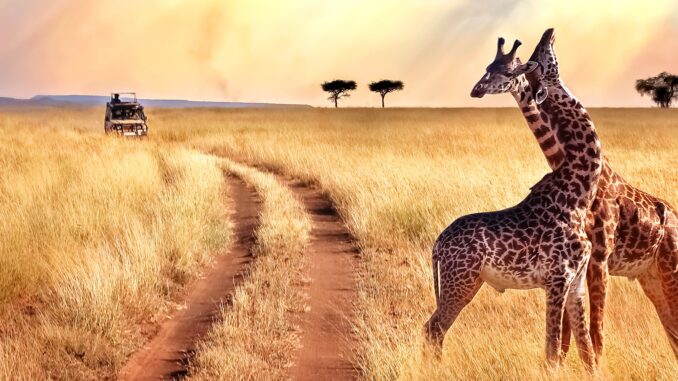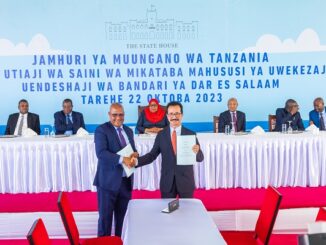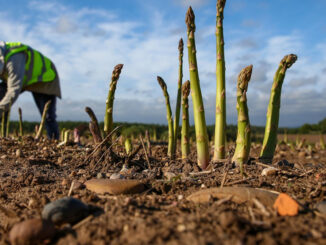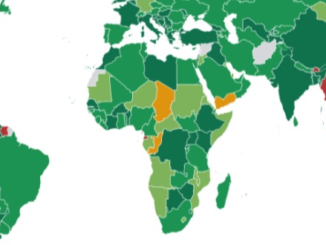
With over one third of its land dedicated as national parks or reserves, starring the Big Five and the Great Wildebeest Migration, it’s no wonder Tanzania is considered Africa’s classic safari destination for first-timers and connoisseurs alike. But East Africa’s largest country is much more than that. You can summit snow-capped Kilimanjaro, the world’s tallest freestanding mountain, or follow Jane Goodall’s footsteps tracking chimps in the remote Gombe Stream National Park. Dive pristine reefs off Indian Ocean islands, discover diverse cultures and cuisines with Swahili, Indian and Arab influences or simply chill on postcard-perfect beaches with sand as soft as white pepper.
Travel restrictions and entry requirements
Tanzania’s latest travel advisory states fully vaccinated travellers need to present their vaccination certificates on arrival. If you’re not fully vaccinated, you’ll need a PCR test within 72 hours before departure, or you can pay around $10 to get a rapid antigen test on arrival. You should also complete a Traveller’s Health Surveillance Form within 24 hours before arrival. On leaving Tanzania, check with your airline/country of arrival to see if they require a test. You’ll need to wear a mask if visiting a testing centre. Visas are required for British travellers, which can be obtained online or on arrival.
Best time to go
Safaris are best in the dry season, when the grasses are low and wildlife can easily be seen, so between June and October in Tanzania’s Northern and Southern safari circuits. This also coincides with the renowned river crossings of the Great Migration in Serengeti, making it the busiest and most expensive time to visit. As an alternative, visit the southern Serengeti in February when some 200,000 calves are born. Kilimanjaro is at its best – and busiest – from late June to September too, but December to March can also bring good conditions for climbing.
Top regions and cities
Serengeti National Park
The star of African safaris, Serengeti means ‘endless plains,’ an apt name for a national park spanning 14,763sqkm, famous for its Great Migration. You’ll witness up to two million wildebeest and zebra traversing the vast savannah on their never-ending quest for fresh fodder. As they stampede northwards, they cross rivers bubbling with eager, evil-looking crocs to reach Kenya’s Maasai Mara, then repeat the ordeal on their return. This frenzied phenomenon lures predators aplenty, along with crowds of tourists, so book your stay way in advance. Choose from a range of accommodation types – from eye-wateringly expensive but classy camps like Singita’s Faru Faru to the National Park’s basic huts and campsites. For some of the best big cat sightings in Africa, head east to the Soit le Motonyi area and the fabulous Namiri Plains camp.
Ngorongoro Crater
Part of the Northern Circuit that includes Serengeti and the smaller parks of Lake Manyara and Tarangire, Ngorongoro is home to a staggering 30,000 animals. It’s the world’s largest intact caldera, measuring 260sq km and the Big Five clique (eles, buffalo, lions, leopards, and rhinos) roam the crater floor, encircled by dramatic escarpments plummeting 600 metres from the rim. Your nearest hotels and lodges lie on the rim: the quirky and ridiculously sumptuous &Beyond Ngorongoro Crater Lodge and the far simpler Rhino Lodge, which supports the local Maasai, are both close to the gate, giving you early morning access ahead of the hordes of visitors.
Zanzibar Island
If you want to wallow on beautiful palm-fringed beaches, sail into the sunset on dhow cruises, or overindulge at full-moon parties, then head to the Indian Ocean paradise of Zanzibar. While you’re there, check out the superb diving around Mnemba Island and snorkel above the pristine coral reefs of Chumbe Island, kitesurf on Paje Beach or visit the friendly fishing villages of Matemwe and Jambiani.
Beyond the beaches, in Jozani Forest, you can spot endangered red colobus monkeys found only on Zanzibar, and tour aromatic spice plantations (it’s not called The Spice Islands for nothing). Discover the heart-rending slave-trade history in the labyrinthine streets of ancient Stone Town, once the capital of Oman. And at dusk, enjoy a cool beer in the bars around Kelele Square watching footie on the beach below, before savouring sizzling kebabs from Forodhani’s lively food market.
Kilimanjaro
Towering 5,895 metres above sea level, Kilimanjaro’s summit is a magnet for keen hikers: you’ll never forget standing on Uhuru Point as dawn breaks over Africa. Annually, some 35,000 climbers weave their way around the seven routes, starting in rainforests and ending at glaciers capping the continent’s highest mountain. Don’t be fooled: it might look like a ginormous molehill and doesn’t need technical skills, but Kili can be a killer. Take time to acclimatise to the lack of oxygen and avoid the shortest, cheapest, lung-busting Marangu route (taking five days). Instead, take the scenic eight-day Lemosho/Shira trail or the more remote Northern Circuit lasting nine days: the longer your trek, the better your chances of summitting.
Best under-the-radar destinations
Ruaha National Park
If raw wilderness is your thing, head to Ruaha. Together with Nyerere (formerly Selous Game Reserve), Mikumi and Udzungwa National Parks, it forms the country’s little-visited Southern Circuit. Ruaha is home to 10 per cent of Africa’s lions, East Africa’s largest population of elephants and several packs of rare wild dogs. But you won’t see many visitors, aside from safari connoisseurs in the know. With just a handful of lodges, it feels as if you have Ruaha’s vast savannahs, rolling hills, golden sand rivers and groves of baobabs all to yourself. Try the new Usangu Expedition Camp in the remote south for hands-on conservation work with a touch of luxury.
Mafia Island
Mafia is how you imagine Zanzibar might have been before tourism hit. Quieter, smaller, but with fewer beaches, it oozes Swahili culture and is still relatively undeveloped, with a handful of lodges dotted around Chole Bay. Come here to dive within the Mafia Island Marine Park, which protects over 450 species of tropical fish, sharks and dolphins, and 50 types of coral. The island’s special guests are migrating whale sharks. You can swim with these gentle giants of the Indian Ocean from October to March – at up to 12 metres long, with some 350 rows of teeth, they eat only plankton and are perfectly safe.
Rubondo Island National Park
Uninhabited by humans, this extraordinary emerald island lying off the southern shores of Lake Victoria is an unlikely home to chimpanzees, giraffes, elephants and rare sitatunga antelopes. The chimps were reintroduced here in the 1960s, rescued from captivity, with elephants and giraffes relocated later. While there’s no guarantee you’ll see our primate cousins, you can help habituate them to people by going out and about with their trackers. Be prepared: chimps are restless creatures and you’ll need to be fit to keep up with them. Alternatively, try bird watching, fish for enormous Nile Perch (weighing up to 100kg), take drives and walks around the island or boat trips on the lake. There’s just one camp here, lying on the lakeshore, but with crocs and hippos bobbing in the water, don’t even think about going for a swim.
Best things to do
Take a walk on Serengeti’s Wild Side
Even in the height of migration season, you can avoid Serengeti’s crowds by walking and camping in its Wilderness Zones with Wayo Africa. It’s not too basic – you have proper beds, private outdoor bathrooms with compost loos and good, old-fashioned bucket showers, hearty meals cooked by your chef, and superb guides who know exactly what to do should you meet a lion on your stroll…
Zanzibar’s Sauti za Busara Swahili Music and Cultural Festival
For four days in February, Zanzibar buzzes to the beats of Swahili music from all over Africa in Stone Town’s atmospheric Old Fort. Up to 400 performers cover everything from traditional Taraab and spiritual music to fusion, urban and hip hop, with fringe events, a parade and beach parties too. Some 20,000 people come for the vibe.
Gems of Arusha
Arusha, Tanzania’s third largest city, is its safari capital and the hub for most northern circuit operators. If you have a day to spare here, ignore the irritating safari-selling touts and take a tour of The Tanzanite Experience. The museum explains the history and process of mining this rare gem, unique to Tanzania, that glistens in shades of blue, violet, or burgundy. Buy the genuine article here: hawkers and shops sell “gemstones” but beware the scams.
Getting around
Scheduled flights with Precision Air, Coastal Aviation and Auric Air, among others, will take you to all the main safari and island destinations, with a good network around the country. Safaris booked through a tour operator will include a 4WD and driver/guide to take you around and between destinations. Express buses drive between Arusha, Moshi (the nearest town to Kilimanjaro) and Dar es Salaam. Local dala-dalas (minibuses) are everywhere but are usually jam-packed and sometimes precarious. Self-drive is also an option. Several ferries run between Dar and Zanzibar and other islands but be aware there have been some tragic accidents in the past, so travel with reputable companies – and never by dhow.
How to get there
Tanzania’s two main airports are Julius Nyerere International Airport in Dar es Salaam and Kilimanjaro International Airport, halfway between Arusha and Moshi, which is the best option for most travellers. Flights vary hugely on cost and duration, with no direct options to Tanzania from London. Kenyan Airways and Ethiopian Airlines offer the best value for money and are the quickest, via Nairobi and Addis Ababa respectively, with Turkish Airlines also a contender. Etihad and Qatar Airways are also good options for flights to Zanzibar, via Dubai and Doha respectively.
Money-saving tip
Don’t get fixed on seeing the Great Migration’s frenzied and often ferocious river crossings to and from the Maasai Mara – costs skyrocket in the Serengeti from June to October. Instead, go when the noisy wildebeest neighbours have left the beautiful northern area and you’ll have time and space to appreciate all the other animals at a fraction of the cost.
FAQs
What’s the weather like?
Tanzania’s weather is generally pleasant and tropical, without huge variations in temperatures through the year. The short rains usually come in November and December, with the long rains in March to May, although locals say the rains are more erratic now due to global warming. Kilimanjaro is always cold on the summit – prepare for water bottles to freeze. The coast can get hot and sticky, reaching around 33 degrees, and the mercury doesn’t descend too much even at night.
What time zone is it in?
GMT + 3 hours
What currency do I need?
Tanzanian shillings.
What language is spoken?
KiSwahili and English are the official languages and English is widely spoken other than in the more remote areas.
Is it safe?
Tanzania is safe if you follow usual precautions: be careful if you’re walking at night, especially in cities and some beaches. On safari, always respect the animals and follow your guide’s instructions whether you’re in a vehicle or on foot. On Kili treks, drink plenty of fluids and let your guide know if you’re feeling unwell – descending is the safest way to recover from high altitude sickness.



